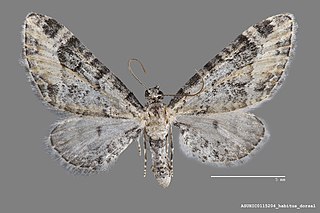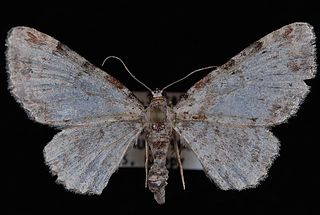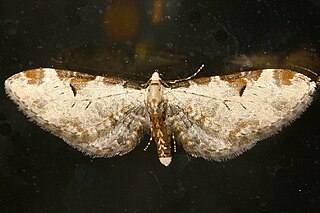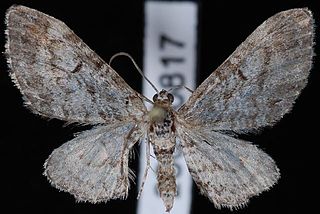
Freyer's pug is a moth of the family Geometridae. The species can be found in Europe, east to the Urals, the Russian Far East, Kazakhstan and China. It is also found in North America.

Eupithecia miserulata, the common eupithecia, is a moth of the family Geometridae. The species was first described by Augustus Radcliffe Grote in 1863 and it can be found in North America, from Ontario and Maine in the north to Florida, Mississippi, Louisiana and Texas in the south. It is also found in Arizona and California.
Eupithecia herefordaria, or Hereford's eupithecia, is a moth in the family Geometridae. It is found in south-eastern Arizona, United States.

Eupithecia cimicifugata is a moth in the family Geometridae first described by Pearsall in 1908. It is found in North America, including Alberta, Ontario, Saskatchewan, Kentucky, Maryland and South Dakota.

Eupithecia agnesata is a moth in the family Geometridae first described by Taylor in 1908. It is found in North America from California through Wyoming, Oregon and Washington to British Columbia.

Eupithecia mutata, the spruce cone looper or cloaked pug, is a moth in the family Geometridae. The species was first described by Pearsall in 1908. It is found in the northern Atlantic and New England states in North America. In Canada, the range extends from Nova Scotia to northern Ontario.

Eupithecia nevadata is a moth in the family Geometridae first described by Alpheus Spring Packard in 1871. It is found in western North America.

Eupithecia graefi, or Graef's pug, is a moth in the family Geometridae. The species was first described by George Duryea Hulst in 1896. It is found in North America from south-western Alberta west to Vancouver Island, north to Alaska and south to California. The habitat consists of wooded areas.

Eupithecia placidata is a moth in the family Geometridae first described by Taylor in 1908. It is found in western North America from British Columbia south to California.

Eupithecia misturata is a moth in the family Geometridae first described by George Duryea Hulst in 1896. It is widely distributed in western North America.

Eupithecia affinata is a moth in the family Geometridae first described by Pearsall in 1908. It is found in North America, including Pennsylvania, New Jersey, New York, Maryland, Maine, Michigan, North Carolina, West Virginia, Kentucky, Ontario and Quebec. It has also been recorded from Arizona and California.
Eupithecia palmata is a moth in the family Geometridae first described by Samuel E. Cassino and Louis W. Swett in 1922. It is found in the US state of California. The habitat consists of deserts.
Eupithecia biedermanata is a moth in the family Geometridae first described by Samuel E. Cassino and Louis W. Swett in 1922. It is found in the US state of Arizona.
Eupithecia zelmira is a moth in the family Geometridae first described by Louis W. Swett and Samuel E. Cassino in 1920. It is found in the US states of Oregon and California.
Eupithecia woodgatata is a moth in the family Geometridae first described by Samuel E. Cassino and Louis W. Swett in 1923. It is found in the US states of Arizona, New Mexico and California.
Eupithecia joanata is a moth in the family Geometridae first described by Samuel E. Cassino and Louis W. Swett in 1922. It is found in southern California, United States.
Eupithecia purpurissata is a moth in the family Geometridae first described by John Arthur Grossbeck in 1908. It is found in the US state of California.

Eupithecia gilvipennata is a moth in the family Geometridae first described by Samuel E. Cassino and Louis W. Swett in 1922. It is found along the North American Pacific coast from British Columbia, through Colorado to California and Arizona.
Eupithecia shirleyata is a moth in the family Geometridae first described by Samuel E. Cassino and Louis W. Swett in 1922. It is found in the US in southern California and Arizona.
Prorella albida is a moth in the family Geometridae first described by Samuel E. Cassino and Louis W. Swett in 1923. It is found in the US states of California, Utah, New Mexico, Colorado and south-western Texas.











